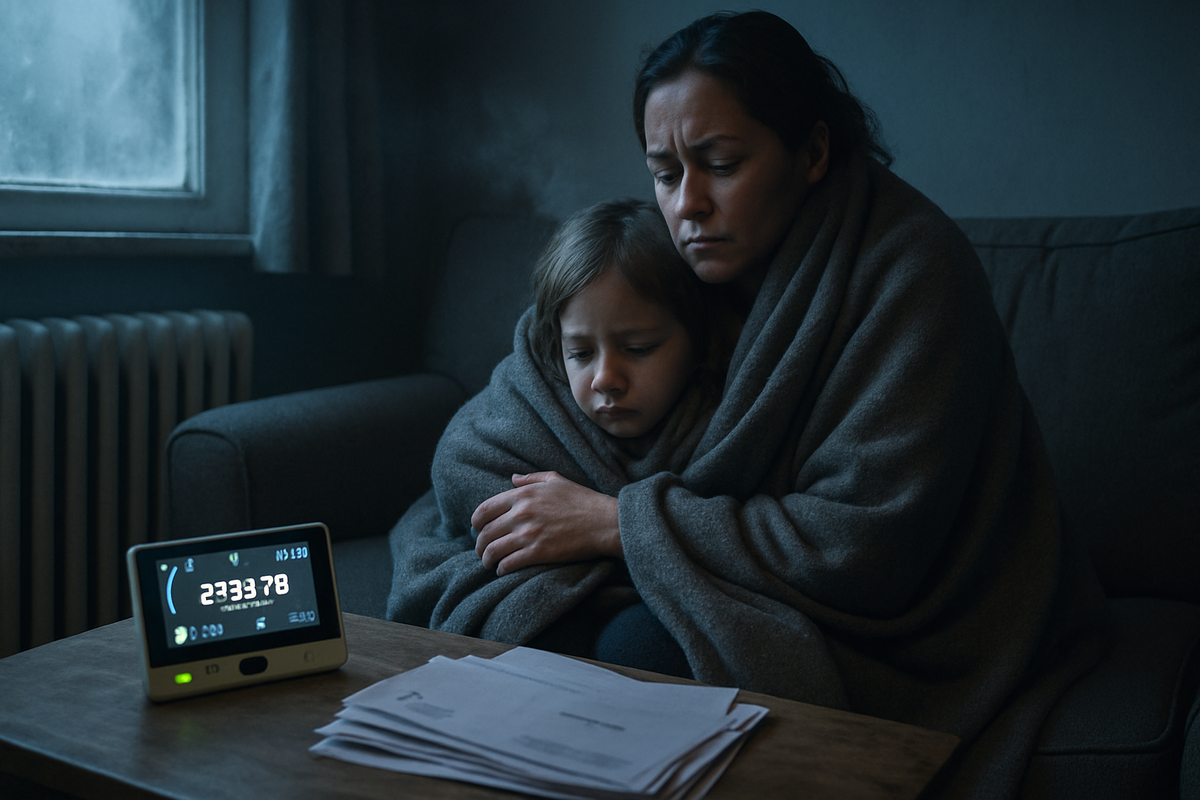
As the chill of winter 2025-2026 looms, a pervasive financial storm is gathering over British households, with consumer energy debt reaching an alarming eight-year high. This escalating crisis, first highlighted by STV News, signals a profound struggle for millions to afford essential heating and power, casting a long shadow over the upcoming colder months. The immediate implications are stark: widespread financial distress, difficult choices for families, and potential disruptions across the energy market as suppliers grapple with unprecedented levels of unpaid bills.
The precarious situation is further complicated by forecasts of volatile energy prices, driven by unpredictable weather patterns, global natural gas market dynamics, and rising operational costs for suppliers. This article delves into the critical implications of this spiraling debt, explores the anticipated pressures on energy prices, and considers the wider societal and economic consequences as the nation braces for a challenging winter.
The Mounting Crisis: An Eight-Year High
The current state of consumer energy debt paints a grim picture, with UK households collectively owing an estimated £780 million to their energy suppliers as they head into winter, according to a Uswitch survey. This represents a staggering 46% increase in indebted households, with 3.5 million currently in arrears, compared to 2.4 million just a year prior. The average household debt has surged by 29% to £223, up from £173. Alarmingly, the average credit balance across all households has dipped below £100 for the first time since the onset of the energy crisis.
Beyond these survey figures, regulator Ofgem's data reveals an even larger scale of the problem, with customers owing energy suppliers a record £4.4 billion, an increase of over £750 million from the previous year. Crucially, more than one million households have no repayment plan in place for their debt, highlighting the severity of the crisis. The timeline leading up to this point has been marked by persistent high energy costs, exacerbated by geopolitical events like the Russia-Ukraine conflict, and the gradual tapering of government support schemes that previously cushioned the blow for many.
Vulnerable populations are disproportionately affected. Over two million low-income households, and ten million UK homes overall, lack the necessary energy credit to manage higher winter bills. A significant portion, one in six homes with an annual income below £20,000, are already in debt, owing an average of £60. Compounding the crisis, 12% of indebted households report being unable to afford their payments—a figure that has doubled in the last year. This financial strain is forcing some to consider drastic measures, with 9% contemplating a move to prepayment meters to manage their debt. The pressure is leading many to adopt severe coping strategies; 40% of households intend to wear more layers at home, and a third plan to lower their thermostat settings. Disturbingly, nearly one in five (18%) households in energy debt have resorted to illegal money lenders for essential bills.
The rise in consumer debt also has a systemic impact on the energy market. "Bad debts"—unpaid household bills—have doubled, now constituting 3-4% of energy retailers' revenue, compared to 1-2% before 2021. These costs are ultimately incorporated into Ofgem's price cap calculations, meaning all consumers indirectly bear the burden of this escalating debt. Ofgem acknowledges the "unsustainable" levels of debt and is exploring solutions, including "debt matching" repayment plans and a proposed Debt Relief Support Scheme. Longer-term data highlights a worrying trend: household energy debt in the UK has tripled over the past decade, with average electricity debt per customer surging from £500 to £1,600, and gas debt from £500 to nearly £1,400 between 2012 and 2024.
Energy Giants Brace for Impact
The unprecedented surge in consumer energy debt presents significant financial and operational challenges for major UK energy suppliers. Companies such as British Gas (part of Centrica (LSE: CNA)), E.ON (XTRA: EOAN), ScottishPower (part of Iberdrola (BME: IBE)), and Octopus Energy are directly impacted as record levels of unpaid bills erode their profitability and strain their resources. Bad debts, which have doubled as a percentage of retailer revenue, directly reduce the bottom line for these firms. Moreover, these unrecoverable costs are factored into Ofgem's price cap, creating a "price spiral" where the defaults of financially vulnerable customers increase costs for everyone, potentially pushing more people into debt.
Operationally, energy companies are facing immense pressure. Many struggle with poor data quality and legacy systems, hindering their ability to accurately identify at-risk customers and tailor effective support. Billing errors, often stemming from inaccurate customer data, lead to poor collection rates. The high volume of customers struggling with debt places immense strain on customer service departments, requiring more resources and specialized training to handle sensitive debt discussions fairly and effectively. Ofgem has also noted that suppliers have not always been quick enough in implementing repayment plans, leading to increased regulatory scrutiny.
In response, major suppliers are deploying various strategies, often in collaboration with regulators and charities. British Gas, through its British Gas Energy Trust, and Octopus Energy with its Octo Assist fund, offer direct financial aid, including grants, payment holidays, and restructured payment plans. E.ON Next and ScottishPower also operate similar hardship funds. These companies are focusing on proactively identifying struggling customers, offering flexible payment plans, and partnering with debt charities like Citizens Advice to provide comprehensive support. The "Winter 2023 Voluntary Debt Commitment," signed by 14 major suppliers, including those mentioned, pledged to go beyond existing regulations to support customers in debt, accompanied by the "SPEAK, SEEK, SAVE" campaign.
While the primary impact is on energy suppliers, the high level of consumer energy debt has ripple effects across the broader financial landscape. The cost of energy debt being socialized across all bills reduces the disposable income of households, indirectly affecting other financial institutions by potentially reducing consumer spending or increasing the risk of defaults on other financial products. For instance, banks could see higher loan defaults as consumers prioritize energy bills. The financial health of energy suppliers is also critical for overall market stability; past supplier failures, often exacerbated by unrecoverable debt, have led to significant disruption and increased costs for all remaining customers.
A Wider Economic Ripple
The crisis of high consumer energy debt extends far beyond the immediate financial strain on households and energy suppliers, creating a wider economic ripple effect across multiple sectors. This situation is deeply intertwined with broader industry trends, including the global energy transition, inflationary pressures, and geopolitical instabilities that continue to drive up energy costs despite recent fluctuations. The declining generation capacity reserves and uncertainties around future load growth, particularly from new demands like data centers and electrified transportation, further underscore the fragility of energy affordability.
The retail sector, already grappling with falling sales and increased online purchasing, faces significantly higher energy bills, squeezing profit margins and potentially leading to slower growth or even insolvency for businesses, especially those with a physical high street presence. Increased transportation costs, driven by rising energy prices for suppliers, also disrupt supply chains and raise operational costs for retailers. In the banking and financial services sector, increased energy debt could lead to higher loan defaults and elevated credit risk, as consumers prioritize energy bills over other expenditures like credit card repayments. Moreover, households struggling with energy debt are more likely to fall into arrears on other priority bills, including rent or mortgage payments, exacerbating housing insecurity. The public services and healthcare sectors also bear the brunt, as financial stress from energy debt can adversely affect mental and physical health, increasing demand for healthcare and social support services.
Regulatory and policy implications extend beyond Ofgem to national governments and international bodies. Governments are implementing enhanced consumer protection measures, with the EU introducing new rules to safeguard vulnerable customers from disconnection. New York State has also enacted legislation to protect consumers from abusive debt collection practices by utility companies. Ofgem is actively exploring a debt relief scheme, potentially a £0.5-1 billion fund, to directly reduce debt for vulnerable customers, aiming for long-term cost-neutrality by reducing the overall socialized cost of bad debt. There's a growing recognition of energy affordability as a key driver for a sustainable pace of emissions reduction, leading to considerations of social tariffs on energy bills for low-income households. Market reforms are also being proposed to create fairer, cheaper, more secure, and efficient energy systems, including greater government responsibility for planning clean energy infrastructure and regulating third-party intermediaries.
Historically, the 1970s energy crisis, triggered by oil embargoes, offers a stark parallel. That period saw quadrupling oil prices, fuel shortages, and economic "stagflation." Government responses included price controls, rationing, and a push for domestic oil production and alternative energy sources. Key parallels with today include geopolitical factors driving price spikes (e.g., the Russia-Ukraine conflict), increased consumer burden, extensive government intervention (then with rationing, now with price caps and debt relief), and a renewed focus on energy independence and diversification towards renewables.
Navigating the Winter Ahead: What Comes Next
The short-term outlook for the energy market and consumers remains challenging. While energy bills have seen some reduction from their absolute peak, they are still significantly higher than pre-2022 levels, ensuring ongoing difficulties for households and exacerbating the debt crisis. Electricity prices in some regions are projected to continue rising through 2030, potentially by as much as 25%, driven by grid expansion, infrastructure projects, and natural gas price volatility. Energy markets will remain subject to volatility, with geopolitical conflicts and shipping disruptions posing risks for sudden price hikes. Consequently, the burden on vulnerable households, including low-income and fuel-poor families, is expected to intensify.
In the long term, the transition to renewables is a dominant trend, with solar and wind power growing fastest. However, oil and natural gas are still projected to constitute more than half of the global energy mix by 2050. Nationwide electricity demand is projected to increase significantly due to data centers, electric vehicles, and electrified heating, necessitating rapid growth in grid resources and infrastructure investments. Affordability will remain a critical factor in the pace of this energy transition, with sustained economic growth and innovation essential to reduce technology costs. Despite the growth of renewables, overall energy costs, including electricity, are expected to remain key cost centers and potentially continue their upward march for at least the next decade, partly due to "non-commodity costs" such as levies for grid upgrades and low-carbon subsidies.
Potential government actions include the continuation and expansion of direct financial aid programs like the Warm Home Discount, alongside the implementation of comprehensive debt relief schemes. Enhanced consumer protections and regulation, such as clearer information on energy offers, easier contact with suppliers, and temporary debt repayment holidays, are also anticipated. Investment in energy efficiency programs will be crucial for long-term poverty alleviation, and market reforms to address the rising burden of non-commodity costs may be explored.
Market adaptations will see energy suppliers incentivized to manage debt more efficiently, as bad debts directly impact their revenues. They are expected to offer tailored repayment plans and temporary debt repayment holidays. Continued investment in smart grid solutions and smart meters will aim to improve billing accuracy and enable a more dynamic energy market. The diversification of energy sources towards renewables will accelerate, driven by declining costs and the desire for reduced reliance on volatile fossil fuels. New tariff structures, including fixed-term/fixed-price and dynamic price contracts, will aim to give consumers more control over their costs and allow them to benefit from cheaper renewable energy. Energy-intensive industries may also adopt revised hedging approaches and greater use of Power Purchase Agreements (PPAs) to secure stable long-term prices.
A Call for Collective Action
The current surge in consumer energy debt to an eight-year high ahead of winter 2025-2026 is a critical indicator of widespread financial vulnerability and structural challenges within the UK energy market. The immediate impact is severe for millions of households, while the ripple effects extend to energy suppliers, other economic sectors, and the broader regulatory landscape. The "socialized" nature of bad debt means that the burden ultimately falls on all consumers, underscoring the urgent need for comprehensive and collaborative solutions.
Moving forward, the market will be defined by ongoing efforts to balance energy affordability with the imperative of the energy transition. Investors should closely watch for regulatory developments, particularly the progress of Ofgem's proposed debt relief schemes and any further government interventions aimed at consumer protection or market reform. The financial health and strategic responses of major energy suppliers like Centrica (LSE: CNA) and E.ON (XTRA: EOAN) will be key indicators of market stability. Furthermore, the pace of investment in energy efficiency and renewable infrastructure, alongside the evolution of tariff structures, will shape the long-term outlook. The ability of the energy sector to adapt to these challenges, while ensuring equitable access to affordable energy, will be paramount in the coming months and years.
This content is intended for informational purposes only and is not financial advice






